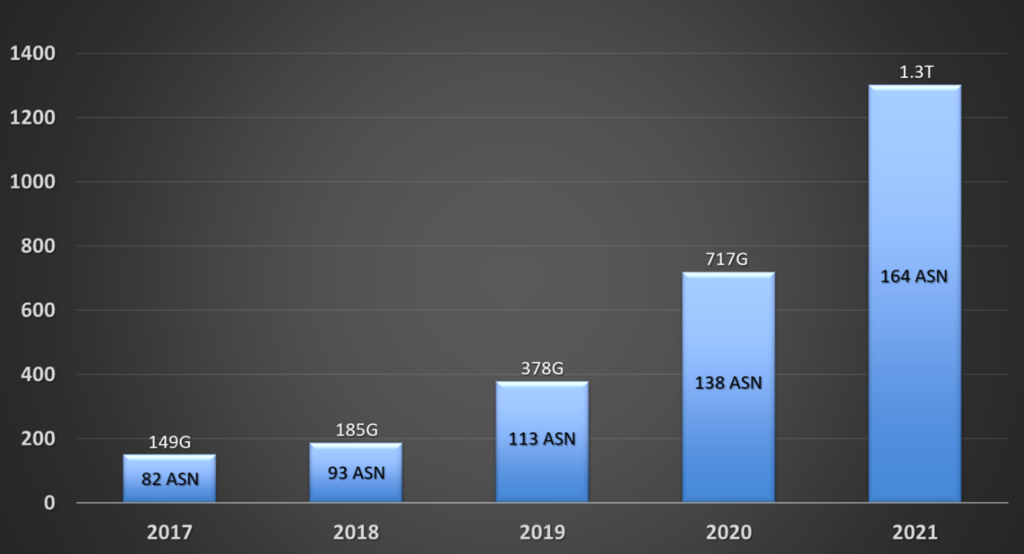
The Singapore Internet Exchange (SGIX) began operation in 2010 as a neutral, not-for-profit Internet exchange managing a distributed peering network that enables all local and international members an enhanced Internet environment at a lower cost. It’s been a success. SGIX currently hosts 180 peers across 10 major data centres in Singapore. In this post, Jeff Chan explains what was behind the difficulties and successes of SGIX, and what the future holds.
SGIX was initiated by the regulator Infocomm Media Development Authority (IMDA) to promote and cement Singapore as the major info-hub in the region. The goal for SGIX was to attract regional and international carriers. In turn, that would increase content hosting in Singapore, and lower latencies. Indirectly, SGIX also stimulated the growth of data centres across the economy. SGIX was incorporated in 2009 as a not-for-profit Internet Exchange (IX) with two locations — one at Global Switch as its primary site, and the other at 1-Net East as its secondary site.
A bumpy ride
Like many new IXs, we had our fair share of challenges from the start. Despite our network being fully operational in 2010, many potential peers were unenthusiastic to come on board due to our relatively small peering base. Nevertheless, we were able to attract 11 to 12 new members every year. In 2015, we had 55 Autonomous System Numbers (ASNs) with traffic peaking at 58G. Despite this, our ASN growth trend had begun to taper, and we needed a new growth plan to move the company forward.
The tough part
We conducted a review of our business strategy and concluded that we needed to expand our service coverage beyond the two existing Points of Presence (PoP). We also needed to start actively seeking out content and social media providers, Content Delivery Networks (CDN) providers, and video streaming and gaming providers to join SGIX. However, the challenge was that many of these providers were hosted in other key data centres where SGIX did not have a presence, and the only way for them to connect to SGIX was through a long local circuit to our node. Clearly, this is a drawback due to the circuit costs that these potential peers would have to bear.
As we were unsure whether there would be substantial demand for SGIX peering from these data centres at that time, we were careful not to make a hasty investment in deploying our own node into these facilities. So, how do we expand our service coverage to reach these peers and make it easier for them to peer with SGIX? We had to rethink our business strategy, service competitiveness, pricing model, and branding.
Hence, we adopted a pragmatic and direct approach to address these challenges. Instead of making a significant investment to procure and deploy switches in new data centres, we engaged several local circuit providers who have good domestic connectivity, using their circuits to link up all targeted sites as well as our main site.
Setting up the satellite sites was the easy part. The commercial consideration was trickier as it involved managing the additional costs associated with the strategy. We eventually decided not to make any distinctions in pricing between main and satellite sites. Peers pay the same port fee when they signed up with SGIX, regardless of where they are connecting from.
In 2017, together with our partners, we rolled out the satellite model and quickly expanded our peering service to many data centres in Singapore. Due to the success of this model, in 2019 we converted one of the key satellite sites to a main site by deploying our own peering switch there to better support the growing demand for SGIX peering.
In this regard, you can see the importance of having coherent commercial and technical strategies — both components must be compelling to the peers.
Business as usual
There are operating costs that need to be managed, even for a not-for-profit IX. But the key difference between us and profit-driven IXs is that SGIX is a company limited by guarantee and does not have shareholders, only members. Abiding by our company charter, we reinvest our company surpluses in infrastructure upgrades, and periodically review our port prices to ensure SGIX remains one of the most efficient and competitive IX in the industry.
SGIX started with only two full-time staff and outsourced most of its business functions to external service providers since its incorporation. It worked well for a decade but as the company continues to grow and is now carrying 1.4T and 180 ASNs, it is time to expand our team, mainly in business operations. Our guiding principle is not to expand for expansion’s sake. And as a not-for-profit IX, cost control remains critical to ensure we stay relevant by offering cost-efficient services to our peers.

Raising awareness
In the past, we organized social and networking events to bring IT professionals together to create awareness of what an Internet Exchange is and what SGIX stands for. But in 2017, we decided to redirect our marketing dollar to sponsor major peering-related events such as APRICOT, Peering Asia, and selected regional NOGs. We believe that supporting these events will better contribute to the peering industry while, in parallel, creating greater brand awareness for the company.
The future
Many would have viewed our growth as rapid, especially over the last five years. But there is still much room for us to further strengthen our peering base. And while doing so, we continue to explore ways to add value to our services, including the study of enhancing our user experience, automation of processes, improving our communications channels, and launching new value-added services, just to name a few.
We’re often asked if SGIX has plans to expand overseas. We do view overseas expansion as a potential avenue for growth, but we need to ask ourselves the following:
- Does setting up an overseas POP allow us to bring more innovative services to that economy?
- How can the overseas POP benefit our existing peers?
- How do we complement existing IXs who are already operating in that economy?
- What is our long-term business plan (organic or inorganic growth)?
- What are SGIX’s operational capabilities and readiness for a smooth deployment overseas?
There are currently many IXs operating in Singapore today. But being the country’s largest not-for-profit IX, SGIX does not view any of the commercial IXs as competitors. SGIX’s mission is clear, that is, to promote Singapore as the info-comm hub in the region and beyond. If for-profit commercial IXs can help contribute to that vision of ours, we welcome them as partners to augment what we do to achieve that goal.
Jeff Chan is the Managing Director of Singapore Internet Exchange. He is responsible for charting the company’s direction forward and managing the overall business operations of the company.
The views expressed by the authors of this blog are their own and do not necessarily reflect the views of APNIC. Please note a Code of Conduct applies to this blog.
